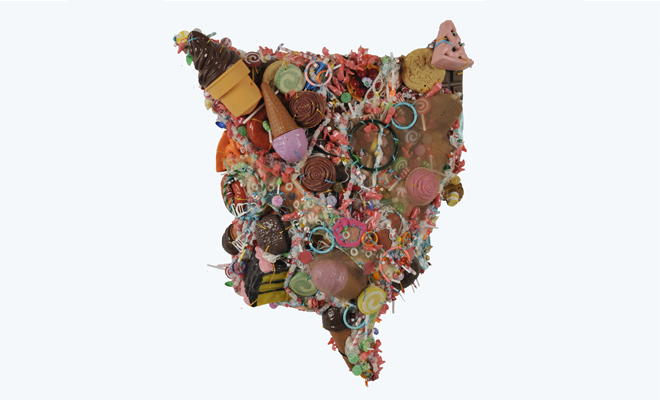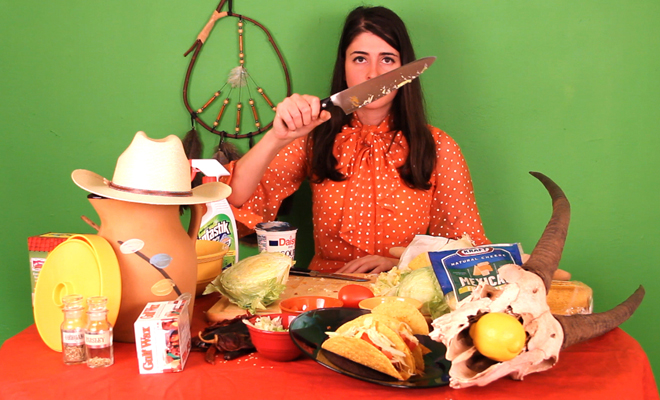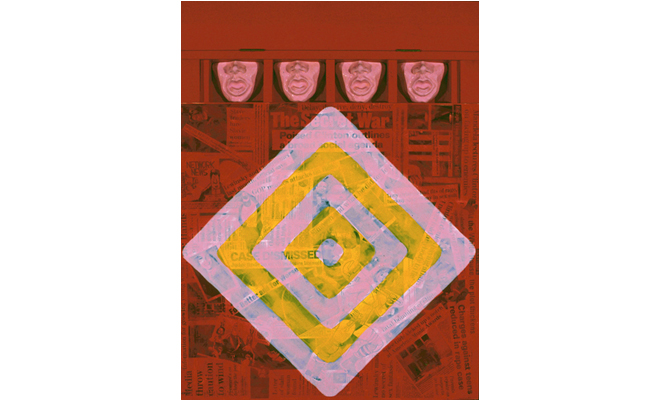Last Call: "Her Infinite Variety" at Barrister's Gallery

Shawne Major, Calisto, 2009. Mixed media consisting of plastic toys (including desserts, barbie doll shoes, candies), bangles, beads, buttons, nylon stockings, and doll hair sewn onto base of fabric and window screen. Courtesy the artist.
Editor's Note
It’s the last weekend to catch "Her Infinite Variety" at Barrister's Gallery. Before it's gone, Emily Wilkerson reviews.
"Age cannot wither her, nor custom stale / Her infinite variety," William Shakespeare, from Antony and Cleopatra
This January, German artist Georg Baselitz made an offensive and outright stupid comment degrading women artists as incapable of creating valuable, market-worthy art. In an interview with Spiegel Online, he stated, “Women don’t paint very well. It’s a fact.” While Baselitz, a white man whose paintings rank among the most expensive in the market (at least before this comment), did deign to regard a few women artists good painters, he continued by explaining that they still didn’t stand up to male painters such as Picasso or Gauguin.
The all-female exhibition “Her Infinite Variety,” on view at Barrister’s Gallery, is dealer and show organizer Andy Antippas’ brilliant local response. The title, which was adopted from Shakespeare’s historic tale of gendered power struggle, also encapsulates the diversity of work shown here and its nearly 50 different creators. From graduate students to arts administrators, teachers, and artists exhibiting internationally, works by Jessica Bizer, Cynthia Ramirez, Elizabeth Shannon, Shawne Major, Courtney Egan, and Michel Varisco, among many talented painters and non-painters, not only highlight the inaccuracies of Baselitz’s comment, but also counter the misconception of women artists producing only so-called feminine or even feminist work. The works in the exhibition vary widely in both subject matter and material, though some do tackle this expectation head on to hilarious effect, such as Sophie T. Lvoff and Nina Schwanse’s collaborative video Semiotics of the Taco (After Martha), 2013. Lvoff’s deadpan narration of ingredients used while preparing tacos, a la Martha Rosler’s Semiotics of the Kitchen, 1975, reminds the viewer of pioneering feminist works in contemporary visual art and the age-old question of where a woman “belongs.”

Sophie T. Lvoff and Nina Schwanse, Semiotics of the Taco (After Martha), 2013 (still). Single channel digital video.
The question of belonging is perhaps the most pressing for this exhibition and gauging if and how identity-themed shows remain relevant today. Assuming there’s something to prove, does an exhibition that serves to demonstrate women’s abilities to produce exceptional artwork necessarily mean an exhibition of solely women artists? Would the same be true of African American, Latino, or Vietnamese artists? And is that answer different in New Orleans than it would be in New York or Berlin? Alas, Baselitz’s remark is an indicator of the continued domination of white male artists in the western art sphere. In 1985, the Guerrilla Girls created a poster that stated, “Women in America earn only 2/3 of what men do. Women artists earn only 1/3 of what men do.” Almost two decades later, in the ad “Horror on the National Mall!” they disclosed the National Gallery of Art’s collection in Washington, D.C. was 98% male with non-white artists representing less than 1% of the collection. How much has changed?
Even in today’s globalized art world, the inclusion of women and artists of color in exhibitions and the sale of their work feels a small fraction of that of white male artists. And while being on top of the market doesn’t symbolize the highest achievement to all, exposure through exhibitions in well-known venues and sales are important to just about every artist’s career. It may be only one man’s reaction, but “Her Infinite Variety” demonstrates the talent of women artists here in New Orleans—both those represented and those whose work is absent from the exhibition. More importantly it recognizes that ongoing conversations on sexism and opportunity in the art world still matter.

Maxx Sizeler, Targeted, 1998. Encaustic, wood, plaster, newspaper articles. Courtesy the artist.
Editor's Note
"Her Infinite Variety" on view through April 6 at Barrister's Gallery (2331 St. Claude Avenue) in New Orleans.



